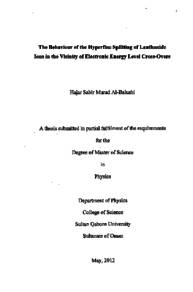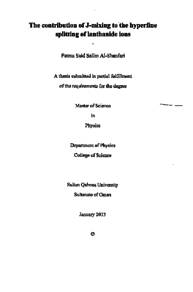وثيقة
The behaviour of the hyperfine spliting of lanthanide ions in the vicinity of electronic energy level cross-overs
الناشر
Sultan Qaboos University
ميلادي
2012
اللغة
الأنجليزية
الموضوع
الملخص الإنجليزي
In lanthanide ions the hyperfine interaction which arises from the coupling of the nuclear moments to the moments of the 4f electronic shell is usually a small perturbation on the electronic states. The splitting of the electronic states by the hyperfine interaction is therefore well described by first-order perturbation theory. However in some compounds there are situations where the perturbation approach to the hyperfine splitting of the electronic states fails. This is the case in the vicinity of an electronic energy-level cross-over. The present thesis is an investigation of the hyperfine splitting of the electronic states of the Ho3+ ion in compounds where such cross-overs occur.
The hyperfine splitting is described by writing a combined electronic and nuclear Hamiltonian representing the interaction of the 4f shell with the crystal environment and with the nucleus. The dimension of the combined Hamiltonian is (2 J + 1) (2 7+ 1), this is 136 for Ho" (J = 8 and 1 = 7/2). Holmium ethylsulphate and holmium lithium fluoride are used as host because in zero applied fields the ground state of Hot is a doublet and, in both compounds there is a low lying state at less than 10 K above the ground doublet.
The computer code used for the investigation was written in Matlab. Computations with a magnetic field applied along the c-axis and in the basal plane are presented. It is found that the dipolar hyperfine interaction admixes the three lowest electronic states. At low fields applied along the c-axis it is found that there are three points where the hyperfine states of the upper and lower halves of the ground doublet avoid each other. Thirteen points where there is repulsion between hyperfine states are observed when the field is applied along the a-axis. In the case with the field applied along the c-axis there is a cross-over between the upper half of the electronic ground doublet and the second excited electronic state. It is found that at this point the states are heavily mixed. The domain over which the perturbation approach breaks down is about 0.6 T around the electronic levels crossing point
المجموعة
URL المصدر
الملخص العربي
إن التفاعل فائق الدقة في العناصر الأرضية النادرة والتي تنتج من الاقتران بين العزوم النووية والعزوم الإلكترونية الموجودة في القشرة 43 عادة تسبب تشوشا ضئيلا على مستويات الطاقة الإلكترونية. إن انقسام مستويات الطاقة الإلكترونية بسبب التفاعلات فائقة الدقة يمكن وصفها بصورة جيدة باستخدام نظرية التشويش من الدرجة الأولى. ولكن في بعض المركبات هناك بعض الحالات التي لا يمكن عندها تفسير الانقسام فائق الدقة لمستويات الطاقة الالكترونية بواسطة نظرية التشويش. هذه الحالات تظهر بالقرب من مناطق تقاطع مستويات الطاقة الالكترونية. هذه الدراسة تبحث الانقسام فائق الدقة لمستويات الطاقة الالكترونية لأيون *Ho في بعض المركبات التي تظهر فيها تقاطع تلك المناطق.
إن الطريقة التي تمت فيها هذه الدراسة تتلخص في كتابة مؤثر طاقة (هاملتونيان مشترك الكتروني ونوري يصف تفاعل الكترونات القشرة 4 مع البلورة ومع نواة الأيون الأم. هذا المؤثر الهاملتوني يمثل بمصفوفة عدد عناصرها (1 +21) (1 + 2) ، ويساوي 136 لأيون +Ho3 ( 8 = ) و (7 / 2 = 1 ) حيث و كميتا التحرك الزاوي الالكتروني والنووي على التوالي. تم استخدام مركب كبريتات إيثيل اليوتيريوم و فلورید اليوتيريوم والليثيوم كبيئة خارجية مضيفة لأيون **Flo لأن عند انعدام المجال المغناطيسي الخارجي فإن مستوى الطاقة الأرضي ينقسم إلى قسمين وفي المركبين يوجد مستوى طاقة متدني طاقته أقل من 10 كلفن اعلى من المستوى الأرضي).
إن الطريقة التي تمت فيها هذه الدراسة تتلخص في كتابة مؤثر طاقة (هاملتونيان مشترك الكتروني ونوري يصف تفاعل الكترونات القشرة 4 مع البلورة ومع نواة الأيون الأم. هذا المؤثر الهاملتوني يمثل بمصفوفة عدد عناصرها (1 +21) (1 + 2) ، ويساوي 136 لأيون +Ho3 ( 8 = ) و (7 / 2 = 1 ) حيث و كميتا التحرك الزاوي الالكتروني والنووي على التوالي. تم استخدام مركب كبريتات إيثيل اليوتيريوم و فلورید اليوتيريوم والليثيوم كبيئة خارجية مضيفة لأيون **Flo لأن عند انعدام المجال المغناطيسي الخارجي فإن مستوى الطاقة الأرضي ينقسم إلى قسمين وفي المركبين يوجد مستوى طاقة متدني طاقته أقل من 10 كلفن اعلى من المستوى الأرضي).
قالب العنصر
الرسائل والأطروحات الجامعية


